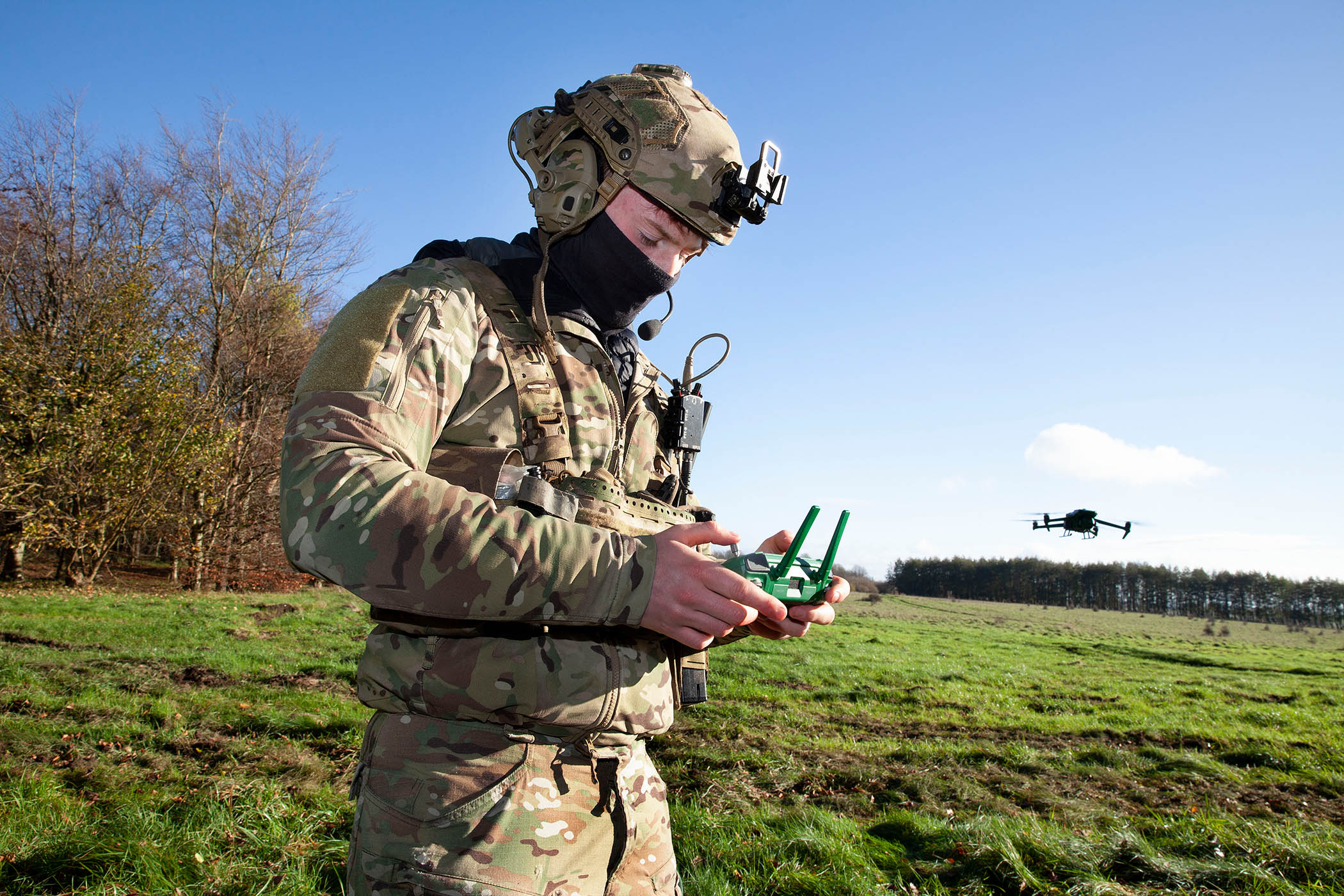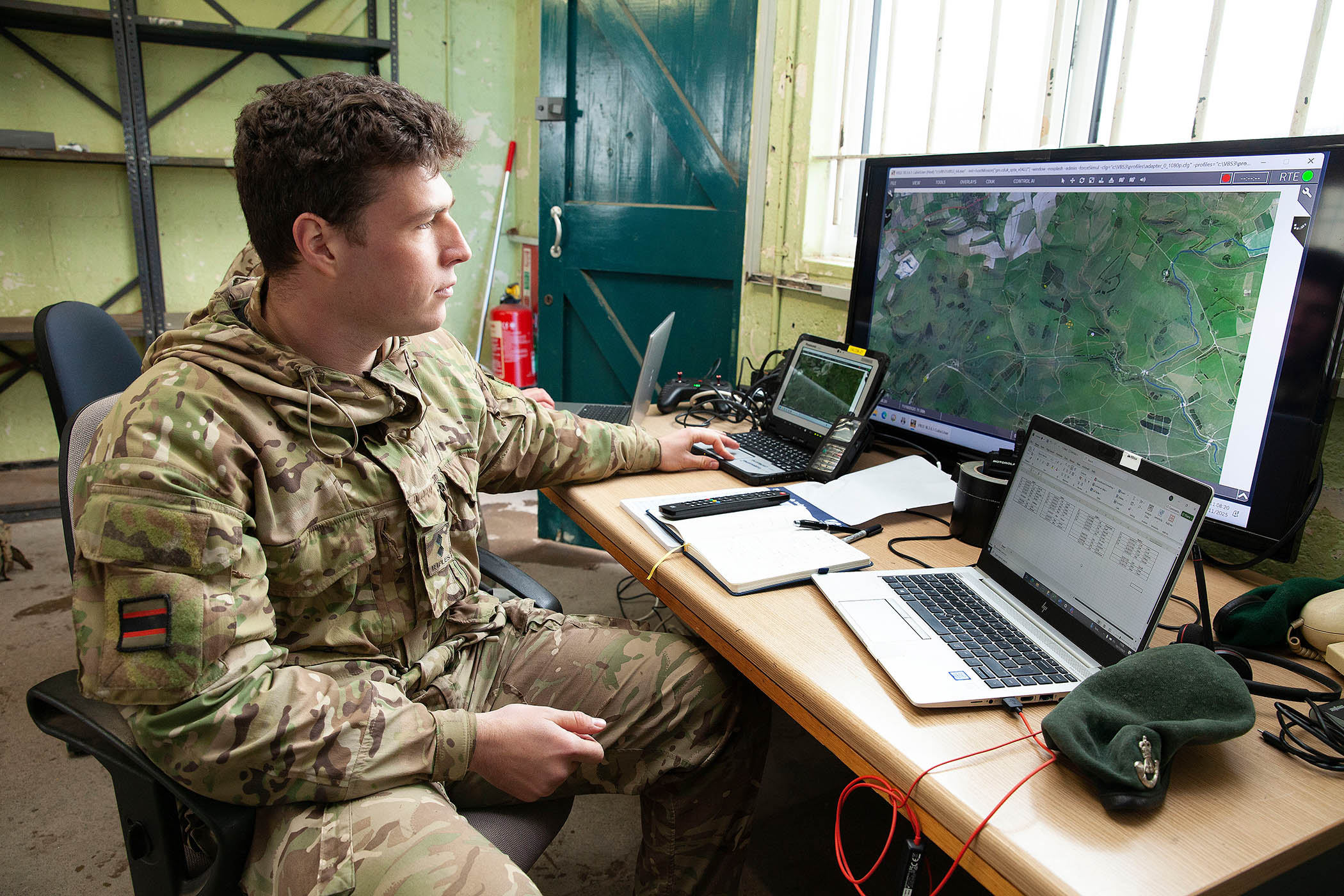A drone rises into the air above the trees and speeds across the open expanse of grass towards the enemy. A young soldier guides it carefully with the controller in his hand, using the image on the screen to place it precisely over his target. He releases the missile; it falls to the ground and explodes. His comrades congratulate him: “Marine Lee has his first kill.” The soldier is thrilled. “It’s addictive,” he says.
The weapon is in fact a water balloon filled with red paint but in a real battle it would be a hand grenade with a “kill zone” of 8 metres (26ft). Five men would have been taken out from hundreds of metres away with the press of a button.
The soldiers are part of Titan Storm, a training exercise on Salisbury Plain. The sound of gunfire echoes across the Wiltshire countryside and armoured vehicles career down muddy tracks. The army has always run war games, but this one is different. For the first time, drones have been integrated into the imaginary battlefield alongside tanks and helicopters as the Ministry of Defence (MoD) prepares for the reality of modern war.
Back in the operations room, Lt Luca Truscott is briefing his specialist drones platoon, part of the Rifles’ armoured infantry battalion. “The technology is advancing at such a rapid rate,” he says. “I can send a drone into a building so I don’t need a soldier to go in and clear it. There are AI drones that scan for minefields and identify enemy targets. In the next five years the army will look very different – a third of the forces might be drone pilots.”
The 19 men in his team were chosen in part for their expertise at video games such as Call of Duty, Fortnite and Battlefield. “The ability to control long-distance drones and strike very precisely is really important,” Truscott says. “The more they game, the better they become.” One of the platoon, L/Cpl Thomas Smith, says the drone controller is identical to a PlayStation console. “I’ve been gaming pretty much my whole life. People used to tell me it was a waste of time but now those skills are seen as really valuable.”
‘Around the time of Agincourt, we gamified [archery] so people had the skills to protect the country’
Lt Gen Tom Copinger-Symes
Drones and artificial intelligence are transforming conflict. In Ukraine, commanders speak of a “drone versus drone war” in which the sky is black with whirring quadcopters and there is an equally fierce unseen fight to control the radio frequencies that allow pilots to fly their machines.
In this country, the government announced last week that Britain is developing autonomous sea drones that can hunt for Russian spy ships. The new Tempest fighter jets, being developed by the UK, Italy and Japan will be surrounded by armed drones for surveillance and attack.
There has been a spate of drone disruptions across Europe and at least 90,000 cyber-attacks on the UK defence system over the last year.
As the national security threat is evolving so is the recruitment and training of the armed forces. John Healey, the defence secretary, said the MoD is actively looking to hire “gamers, coders [and people] that are confident, skilled or passionate about tech”. A direct entry scheme has been set up so the cyber-recruits do not have to go through the standard fitness training programme. The first group of 30 was enrolled this year.
The armed forces are also adapting for the new generation of soldiers. One of the two flagship aircraft carriers, the Prince of Wales, has a fully equipped esports room onboard.
The shift in priorities has raised questions about whether increasingly sophisticated military technology is leading to a gamification of war. Last Friday, the first International Defence Esports Games launched in London, sponsored by defence contractors, including BAE Systems. More than 40 countries competed in the tournament, which involved a drone display and a virtual battle between military gamers from around the world. The finals will take place next year.

A marine operates a military drone while taking part in the Titan Storm exercise on Salisbury Plain
Lt Gen Sir Tom Copinger-Symes, deputy commander of the cyber and specialist operations command, believes the threat is evolving so fast that the armed forces must transform their capabilities. “We are not at war but nor are we at peace. We’ve seen assassination, sabotage, psychological operations and we are seeing an awful lot of cyber-activity,” he says.
“At the time of Agincourt, the British archers won by defeating the French cavalry. At that stage, we had archery targets in every single village in England and Wales. We gamified something that meant at a time of national crisis we had the right skills and people available to protect the country. I genuinely think we can use esports and gaming to build the right skills and engage a whole bunch of people who wouldn’t think of coming to work in national security.”
The precision of the latest drones means that missiles can, if they are properly used, be better targeted to avoid civilians. They can also be operated remotely, reducing the risk to soldiers by keeping them away from the frontline.
But Iain Overton, executive director of Action on Armed Violence, a conflict monitoring group, warns that the gamification of combat risks dehumanising war. “Drones and AI systems turn killing into a technical process. When life and death resemble a computer game or a workflow, the ethical weight that once accompanied lethal force drains away. If killing is as simple as a flick of a switch, then killing expands and blossoms without restraint.”
In Ukraine, military units compete for points under the “army of drones bonus system”. They get 12 points for killing a Russian soldier and 40 for destroying a tank. Points can be exchanged for prizes through an Amazon-style weapons store. More than 400 drone teams have taken part in the competition. There have been versions of this throughout history. In the first world war, a “flying ace” was a pilot who had shot down at least five enemy planes and during the Vietnam conflict, some soldiers collected human ears as grim trophies. But the data-driven nature of modern warfare means outcomes are easier to codify and the violence portrayed in many video games is often gruesomely close to the real thingAI is increasingly being integrated into military systems to allow drones to operate autonomously according to certain instructions. The computer scientist Stuart Russell is among those who has warned of the danger of supposed “killer robots” – autonomous weapons that can find, track and fire on targets without human supervision.
David Lidington, the former Conservative cabinet minister and ex-chair of the Royal United Services Institute, believes the impact of technology on the military raises “profound ethical questions” as weapons systems are developed that are capable of mimicking intelligent thought. “You will be able to programme a missile using AI to seek out particular targets and make choices about targets without the need for a human being to intervene,” he says.
“If something goes wrong, if a drone or an uncrewed aircraft were to act in a way that caused massive civilian collateral damage, or turned out to harm the wrong people, who is actually accountable for that? Is it the man or woman sitting miles away with a laptop who has pressed the key to engage? Is it the senior commander who has signed off the overarching rules of engagement? Or is it the designer of the algorithm?”
Photographs by Karen Robinson for The Observer

